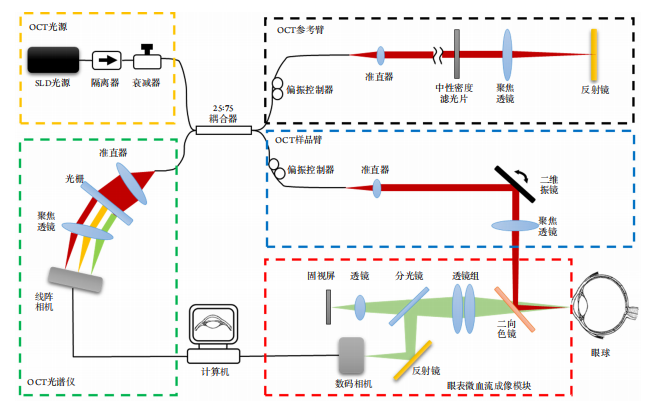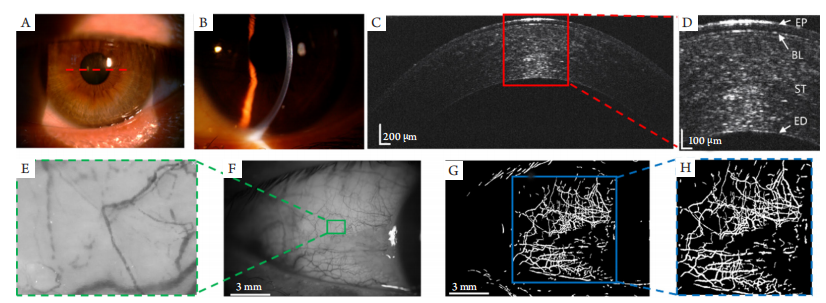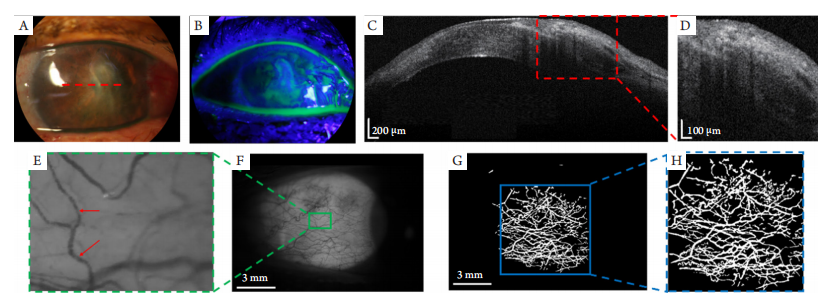1、Oliva MS, Schottman T, Gulati M. Turning the tide of corneal
blindness[ J]. Indian J Ophthalmol, 2012, 60(5): 423.Oliva MS, Schottman T, Gulati M. Turning the tide of corneal
blindness[ J]. Indian J Ophthalmol, 2012, 60(5): 423.
2、Pascolini D, Mariotti SP. Global estimates of visual impairment[ J]. Br J
Ophthalmol, 2012, 96(5): 614-618.Pascolini D, Mariotti SP. Global estimates of visual impairment[ J]. Br J
Ophthalmol, 2012, 96(5): 614-618.
3、Whitcher JP, Srinivasan M, Upadhyay MP. Corneal blindness: a global
perspective[ J]. Bull World Health Organ, 2001, 79: 214-221.Whitcher JP, Srinivasan M, Upadhyay MP. Corneal blindness: a global
perspective[ J]. Bull World Health Organ, 2001, 79: 214-221.
4、Youlten LJF. Inflammatory mediators and vascular events[M]//
Inflammation. Berlin, Heidelberg: Springer, 1978: 571-587.Youlten LJF. Inflammatory mediators and vascular events[M]//
Inflammation. Berlin, Heidelberg: Springer, 1978: 571-587.
5、Abdulkhaleq LA, Assi MA, Abdullah R, et al. The crucial roles of
inflammatory mediators in inflammation: A review[ J]. Veterinary
World, 2018, 11(5): 627.Abdulkhaleq LA, Assi MA, Abdullah R, et al. The crucial roles of
inflammatory mediators in inflammation: A review[ J]. Veterinary
World, 2018, 11(5): 627.
6、Mondino BJ. Inflammatory diseases of the peripheral cornea[ J].
Ophthalmology, 1988, 95: 463-472.Mondino BJ. Inflammatory diseases of the peripheral cornea[ J].
Ophthalmology, 1988, 95: 463-472.
7、Oatts JT, Keenan JD, Mannis T, et al. Multimodal assessment of corneal
thinning using optical coherence tomography, scheimpflug imaging,
pachymetry and slit lamp examination[ J]. Cornea, 2017, 36(4): 425.Oatts JT, Keenan JD, Mannis T, et al. Multimodal assessment of corneal
thinning using optical coherence tomography, scheimpflug imaging,
pachymetry and slit lamp examination[ J]. Cornea, 2017, 36(4): 425.
8、Mantopoulos D, Cruzat A, Hamrah P. In vivo imaging of corneal
inflammation: new tools for clinical practice and research[ J]. Semin
Ophthalmol, 2010, 25(5/6): 178-185.Mantopoulos D, Cruzat A, Hamrah P. In vivo imaging of corneal
inflammation: new tools for clinical practice and research[ J]. Semin
Ophthalmol, 2010, 25(5/6): 178-185.
9、van den Berg TJTP. Intraocular light scatter, reflections, fluorescence
and absorption: what we see in the slit lamp[ J]. Ophthalmic Physiol
Opt, 2018, 38(1): 6-25.van den Berg TJTP. Intraocular light scatter, reflections, fluorescence
and absorption: what we see in the slit lamp[ J]. Ophthalmic Physiol
Opt, 2018, 38(1): 6-25.
10、Yuan J, Jiang H, Mao X, et al. Slit-lamp photography and videography
with high magnifications[ J]. Eye Contact Lens, 2015, 41(6): 391.Yuan J, Jiang H, Mao X, et al. Slit-lamp photography and videography
with high magnifications[ J]. Eye Contact Lens, 2015, 41(6): 391.
11、Stanzel TP, Devarajan K, Lwin NC, et al. Comparison of optical
coherence tomography angiography to indocyanine green angiography
and slit lamp photography for corneal vascularization in an animal
model[ J]. Sci Rep, 2018, 8(1): 11493.Stanzel TP, Devarajan K, Lwin NC, et al. Comparison of optical
coherence tomography angiography to indocyanine green angiography
and slit lamp photography for corneal vascularization in an animal
model[ J]. Sci Rep, 2018, 8(1): 11493.
12、Oliphant H, Kennedy A, Comyn O, et al. Commercial slit lamp anterior
segment photography versus digital compact camera mounted on a
standard slit lamp with an adapter[ J]. Curr Eye Res, 2018, 43(10):
1290-1294.Oliphant H, Kennedy A, Comyn O, et al. Commercial slit lamp anterior
segment photography versus digital compact camera mounted on a
standard slit lamp with an adapter[ J]. Curr Eye Res, 2018, 43(10):
1290-1294.
13、Wilson G, Ren H, Laurent J. Corneal epithelial fluorescein staining[ J].
J Am Optom Assoc, 1995, 66(7): 435.Wilson G, Ren H, Laurent J. Corneal epithelial fluorescein staining[ J].
J Am Optom Assoc, 1995, 66(7): 435.
14、Huang D, Swanson EA , Lin CP, et a l . Optical coherence
tomography[ J]. Science, 1991, 254(5035): 1178-1181.Huang D, Swanson EA , Lin CP, et a l . Optical coherence
tomography[ J]. Science, 1991, 254(5035): 1178-1181.
15、Adhi M, Duker JS. Optical coherence tomography–current and future
applications[ J]. Curr Opin Ophthalmol, 2013, 24(3): 213.Adhi M, Duker JS. Optical coherence tomography–current and future
applications[ J]. Curr Opin Ophthalmol, 2013, 24(3): 213.
16、Drexler W, Liu M, Kumar A, et al. Optical coherence tomography
today: speed, contrast, and multimodality[ J]. J. Biomed Opt, 2014,
19(7): 071412.Drexler W, Liu M, Kumar A, et al. Optical coherence tomography
today: speed, contrast, and multimodality[ J]. J. Biomed Opt, 2014,
19(7): 071412.
17、Mazlin V, Xiao P, Dalimier E, et al. In vivo high resolution human
corneal imaging using full-field optical coherence tomography[ J].
Biomed Opt Express, 2018, 9(2): 557-568.Mazlin V, Xiao P, Dalimier E, et al. In vivo high resolution human
corneal imaging using full-field optical coherence tomography[ J].
Biomed Opt Express, 2018, 9(2): 557-568.
18、Xiao P, Mazlin V, Grieve K, et al. In vivo high-resolution human retinal
imaging with wavefront-correctionless full-field OCT[ J]. Optica, 2018,
5(4): 409-412.Xiao P, Mazlin V, Grieve K, et al. In vivo high-resolution human retinal
imaging with wavefront-correctionless full-field OCT[ J]. Optica, 2018,
5(4): 409-412.
19、Ang M, Baskaran M, Werkmeister RM, et al. Anterior segment optical
coherence tomography[ J]. Prog Retin Eye Res, 2018, 66: 132-156.Ang M, Baskaran M, Werkmeister RM, et al. Anterior segment optical
coherence tomography[ J]. Prog Retin Eye Res, 2018, 66: 132-156.
20、Nanji AA, Sayyad FE, Galor A, et al. High-resolution optical coherence
tomography as an adjunctive tool in the diagnosis of corneal and
conjunctival pathology[ J]. Ocul Surf, 2015, 13(3): 226-235.Nanji AA, Sayyad FE, Galor A, et al. High-resolution optical coherence
tomography as an adjunctive tool in the diagnosis of corneal and
conjunctival pathology[ J]. Ocul Surf, 2015, 13(3): 226-235.
21、Fercher AF. Optical coherence tomography[ J]. J Biomed Opt, 1996,
1(2): 157-173.Fercher AF. Optical coherence tomography[ J]. J Biomed Opt, 1996,
1(2): 157-173.
22、Fujimoto JG, Drexler W. Optical coherence tomography: technology
and applications[M]. New York: Springer Science & Business Media,
2008.Fujimoto JG, Drexler W. Optical coherence tomography: technology
and applications[M]. New York: Springer Science & Business Media,
2008.
23、Werkmeister RM, Alex A, Kaya S, et al. Measurement of tear film
thickness using ultrahigh-resolution optical coherence tomography[ J].
Invest Ophthalmol Vis Sci, 2013, 54(8): 5578-5583.Werkmeister RM, Alex A, Kaya S, et al. Measurement of tear film
thickness using ultrahigh-resolution optical coherence tomography[ J].
Invest Ophthalmol Vis Sci, 2013, 54(8): 5578-5583.
24、Du C, Shen M, Li M, et al. Anterior segment biometry during
accommodation imaged with ultralong scan depth optical coherence
tomography[ J]. Ophthalmology, 2012, 119(12): 2479-2485.Du C, Shen M, Li M, et al. Anterior segment biometry during
accommodation imaged with ultralong scan depth optical coherence
tomography[ J]. Ophthalmology, 2012, 119(12): 2479-2485.
25、Bizheva K, Tan B, MacLelan B, et al. Sub-micrometer axial resolution
OCT for in-vivo imaging of the cellular structure of healthy and
keratoconic human corneas[ J]. Biomed Opt Express, 2017, 8(2):
800-812.Bizheva K, Tan B, MacLelan B, et al. Sub-micrometer axial resolution
OCT for in-vivo imaging of the cellular structure of healthy and
keratoconic human corneas[ J]. Biomed Opt Express, 2017, 8(2):
800-812.
26、Christopoulos V, Kagemann L, Wollstein G, et al. In vivo corneal high-
speed, ultra–high-resolution optical coherence tomography[ J]. Arch
Ophthalmol, 2007, 125(8): 1027-1035.Christopoulos V, Kagemann L, Wollstein G, et al. In vivo corneal high-
speed, ultra–high-resolution optical coherence tomography[ J]. Arch
Ophthalmol, 2007, 125(8): 1027-1035.
27、Pantalon A, Pfister M, Aranha dos Santos V, et al. Ultrahigh‐resolution
anterior segment optical coherence tomography for analysis of corneal
microarchitecture during wound healing[ J]. Acta Ophthalmol, 2019,
97(5): e761-e771.Pantalon A, Pfister M, Aranha dos Santos V, et al. Ultrahigh‐resolution
anterior segment optical coherence tomography for analysis of corneal
microarchitecture during wound healing[ J]. Acta Ophthalmol, 2019,
97(5): e761-e771.
28、Shousha MA, Karp CL, Perez VL, et al. Diagnosis and management
of conjunctival and corneal intraepithelial neoplasia using ultra high-
resolution optical coherence tomography[ J]. Ophthalmology, 2011,
118(8): 1531-1537.Shousha MA, Karp CL, Perez VL, et al. Diagnosis and management
of conjunctival and corneal intraepithelial neoplasia using ultra high-
resolution optical coherence tomography[ J]. Ophthalmology, 2011,
118(8): 1531-1537.
29、Br unner M, Romano V, Steger B, et al. Imaging of corneal
neovascularization: optical coherence tomography angiography and
fluorescence angiography[ J]. Invest Ophthalmol Vis Sci, 2018, 59(3):
1263-1269.Br unner M, Romano V, Steger B, et al. Imaging of corneal
neovascularization: optical coherence tomography angiography and
fluorescence angiography[ J]. Invest Ophthalmol Vis Sci, 2018, 59(3):
1263-1269.
30、Lee WD, Devarajan K, Chua J, et al. Optical coherence tomography
angiography for the anterior segment[ J]. Eye Vis (Lond), 2019, 6(1): 4.Lee WD, Devarajan K, Chua J, et al. Optical coherence tomography
angiography for the anterior segment[ J]. Eye Vis (Lond), 2019, 6(1): 4.
31、Jiang H, Zhong J, DeBuc DC, et al. Functional slit lamp biomicroscopy
for imaging bulbar conjunctival microvasculature in contact lens
wearers[ J]. Microvasc Res, 2014, 92: 62-71.Jiang H, Zhong J, DeBuc DC, et al. Functional slit lamp biomicroscopy
for imaging bulbar conjunctival microvasculature in contact lens
wearers[ J]. Microvasc Res, 2014, 92: 62-71.
32、Wang L, Yuan J, Jiang H, et al. Vessel sampling and blood flow velocity
distribution with vessel diameter for characterizing the human bulbar
conjunctival microvasculature[ J]. Eye Contact Lens, 2016, 42(2): 135.Wang L, Yuan J, Jiang H, et al. Vessel sampling and blood flow velocity
distribution with vessel diameter for characterizing the human bulbar
conjunctival microvasculature[ J]. Eye Contact Lens, 2016, 42(2): 135.
33、Xu Z, Jiang H, Tao A, et al. Measurement variability of the bulbar
conjunctival microvasculature in healthy subjects using functional slit
lamp biomicroscopy (FSLB)[ J]. Microvasc Res, 2015, 101: 15-19.Xu Z, Jiang H, Tao A, et al. Measurement variability of the bulbar
conjunctival microvasculature in healthy subjects using functional slit
lamp biomicroscopy (FSLB)[ J]. Microvasc Res, 2015, 101: 15-19.
34、Cheung ATW, Hu BS, Wong SA, et al. Microvascular abnormalities
in the bulbar conjunctiva of contact lens users[ J]. Clin Hemorheol
Microcirc, 2012, 51(1): 77-86.Cheung ATW, Hu BS, Wong SA, et al. Microvascular abnormalities
in the bulbar conjunctiva of contact lens users[ J]. Clin Hemorheol
Microcirc, 2012, 51(1): 77-86.
35、Chen W, Deng Y, Jiang H, et al. Microvascular abnormalities in dry eye
patients[ J]. Microvasc Res, 2018, 118: 155-161.Chen W, Deng Y, Jiang H, et al. Microvascular abnormalities in dry eye
patients[ J]. Microvasc Res, 2018, 118: 155-161.
36、Mujat M, Ferguson RD, Patel AH, et al. High resolution multimodal
clinical ophthalmic imaging system[ J]. Opt Express, 2010, 18(11):
11607-11621.Mujat M, Ferguson RD, Patel AH, et al. High resolution multimodal
clinical ophthalmic imaging system[ J]. Opt Express, 2010, 18(11):
11607-11621.
37、Malone JD, El-Haddad MT, Bozic I, et al. Simultaneous multimodal
ophthalmic imaging using swept-source spectrally encoded scanning
laser ophthalmoscopy and optical coherence tomography[ J]. Biomed
Opt Express, 2016, 8(1): 193-206.Malone JD, El-Haddad MT, Bozic I, et al. Simultaneous multimodal
ophthalmic imaging using swept-source spectrally encoded scanning
laser ophthalmoscopy and optical coherence tomography[ J]. Biomed
Opt Express, 2016, 8(1): 193-206.
38、Song W, Wei Q, Liu T, et al. Integrating photoacoustic ophthalmoscopy
with scanning laser ophthalmoscopy, optical coherence tomography,
and fluorescein angiography for a multimodal retinal imaging
platform[ J]. J Biomed Opt, 2012, 17(6): 061206.Song W, Wei Q, Liu T, et al. Integrating photoacoustic ophthalmoscopy
with scanning laser ophthalmoscopy, optical coherence tomography,
and fluorescein angiography for a multimodal retinal imaging
platform[ J]. J Biomed Opt, 2012, 17(6): 061206.
39、Felberer F, Kroisamer JS, Baumann B, et al. Adaptive optics SLO/
OCT for 3D imaging of human photoreceptors in vivo[ J]. Biomed Opt
Express, 2014, 5(2): 439-456.Felberer F, Kroisamer JS, Baumann B, et al. Adaptive optics SLO/
OCT for 3D imaging of human photoreceptors in vivo[ J]. Biomed Opt
Express, 2014, 5(2): 439-456.
40、Zawadzki RJ, Zhang P, Zam A, et al. Adaptive-optics SLO imaging
combined with widefield OCT and SLO enables precise 3D localization
of fluorescent cells in the mouse retina[ J]. Biomed Opt Express, 2015,6(6): 2191-2210.Zawadzki RJ, Zhang P, Zam A, et al. Adaptive-optics SLO imaging
combined with widefield OCT and SLO enables precise 3D localization
of fluorescent cells in the mouse retina[ J]. Biomed Opt Express, 2015,6(6): 2191-2210.
41、Stehouwer M, Verbraak FD, De Vries H, et al. Fourier domain optical
coherence tomography integrated into a slit lamp; a novel technique
combining anterior and posterior segment OCT[ J]. Eye, 2010, 24(6):
980-984.Stehouwer M, Verbraak FD, De Vries H, et al. Fourier domain optical
coherence tomography integrated into a slit lamp; a novel technique
combining anterior and posterior segment OCT[ J]. Eye, 2010, 24(6):
980-984.
42、Mueller M, Schulz-Wackerbarth C, Steven P, et al. Slit-lamp-adapted
fourier-domain OCT for anterior and posterior segments: preliminary
results and comparison to time-domain OCT[ J]. Curr Eye Res, 2010,
35(8): 722-732.Mueller M, Schulz-Wackerbarth C, Steven P, et al. Slit-lamp-adapted
fourier-domain OCT for anterior and posterior segments: preliminary
results and comparison to time-domain OCT[ J]. Curr Eye Res, 2010,
35(8): 722-732.
43、Schiano-Lomoriello D, Bono V, Abicca I, et al. Repeatability of anterior
segment measurements by optical coherence tomography combined
with Placido disk corneal topography in eyes with keratoconus[ J]. Sci
Rep, 2020, 10(1): 1124.Schiano-Lomoriello D, Bono V, Abicca I, et al. Repeatability of anterior
segment measurements by optical coherence tomography combined
with Placido disk corneal topography in eyes with keratoconus[ J]. Sci
Rep, 2020, 10(1): 1124.
44、R abinowitz YS, Li X , Canedo ALC, et al. Optical coherence
tomography combined with videokeratography to differentiate mild
keratoconus subtypes[ J]. J Refract Surg, 2014, 30(2): 80-87.R abinowitz YS, Li X , Canedo ALC, et al. Optical coherence
tomography combined with videokeratography to differentiate mild
keratoconus subtypes[ J]. J Refract Surg, 2014, 30(2): 80-87.
45、Savini G, Barboni P, Carbonelli M, et al. Repeatability of automatic
measurements by a new Scheimpflug camera combined with Placido
topography[ J]. J Cataract Refract Surg, 2011, 37(10): 1809-1816.Savini G, Barboni P, Carbonelli M, et al. Repeatability of automatic
measurements by a new Scheimpflug camera combined with Placido
topography[ J]. J Cataract Refract Surg, 2011, 37(10): 1809-1816.
46、American National Standards Institute. American National Standard for
Ophthalmics—Light Hazard Protection for Ophthalmic Instruments,
ANSI Z80.36-2016[R]. New York, NY, USA: American National
Standards Institute, 2016.American National Standards Institute. American National Standard for
Ophthalmics—Light Hazard Protection for Ophthalmic Instruments,
ANSI Z80.36-2016[R]. New York, NY, USA: American National
Standards Institute, 2016.
47、Atchison DA, Smith G. Optics of the human eye[M]. Boston:
Butterworth-Heinemann, 2000.Atchison DA, Smith G. Optics of the human eye[M]. Boston:
Butterworth-Heinemann, 2000.
48、Koutsiaris AG, Tachmitzi SV, Batis N, et al. Volume flow and wall shear
stress quantification in the human conjunctival capillaries and post-
capillary venules in vivo[ J]. Biorheology, 2007, 44(5/6): 375-386.Koutsiaris AG, Tachmitzi SV, Batis N, et al. Volume flow and wall shear
stress quantification in the human conjunctival capillaries and post-
capillary venules in vivo[ J]. Biorheology, 2007, 44(5/6): 375-386.
49、Hogarty DT, Mackey DA, Hewitt AW. Current state and future
prospects of artificial intelligence in ophthalmology: a review[ J]. Clin
Exp Ophthalmol, 2019, 47(1): 128-139.Hogarty DT, Mackey DA, Hewitt AW. Current state and future
prospects of artificial intelligence in ophthalmology: a review[ J]. Clin
Exp Ophthalmol, 2019, 47(1): 128-139.
50、Ting DSW, Pasquale LR, Peng L, et al. Artificial intelligence and
deep learning in ophthalmology[ J]. Br J Ophthalmol, 2019, 103(2):
167-175.Ting DSW, Pasquale LR, Peng L, et al. Artificial intelligence and
deep learning in ophthalmology[ J]. Br J Ophthalmol, 2019, 103(2):
167-175.






